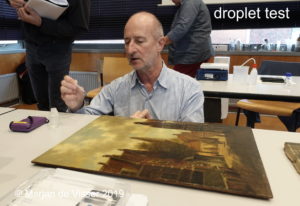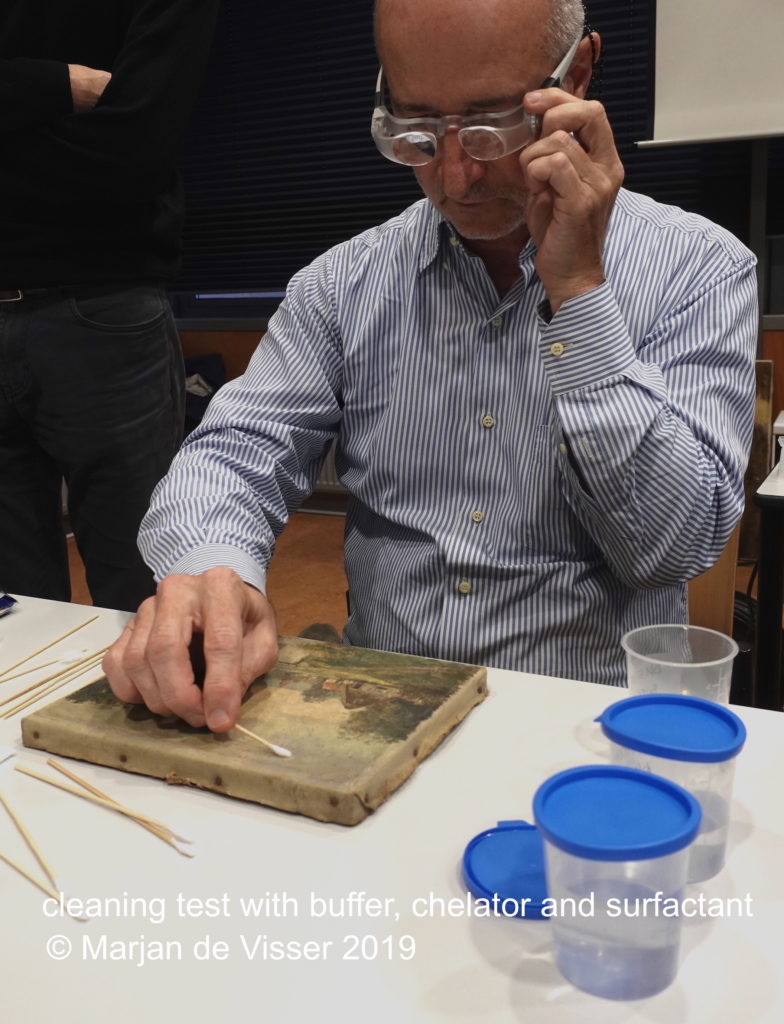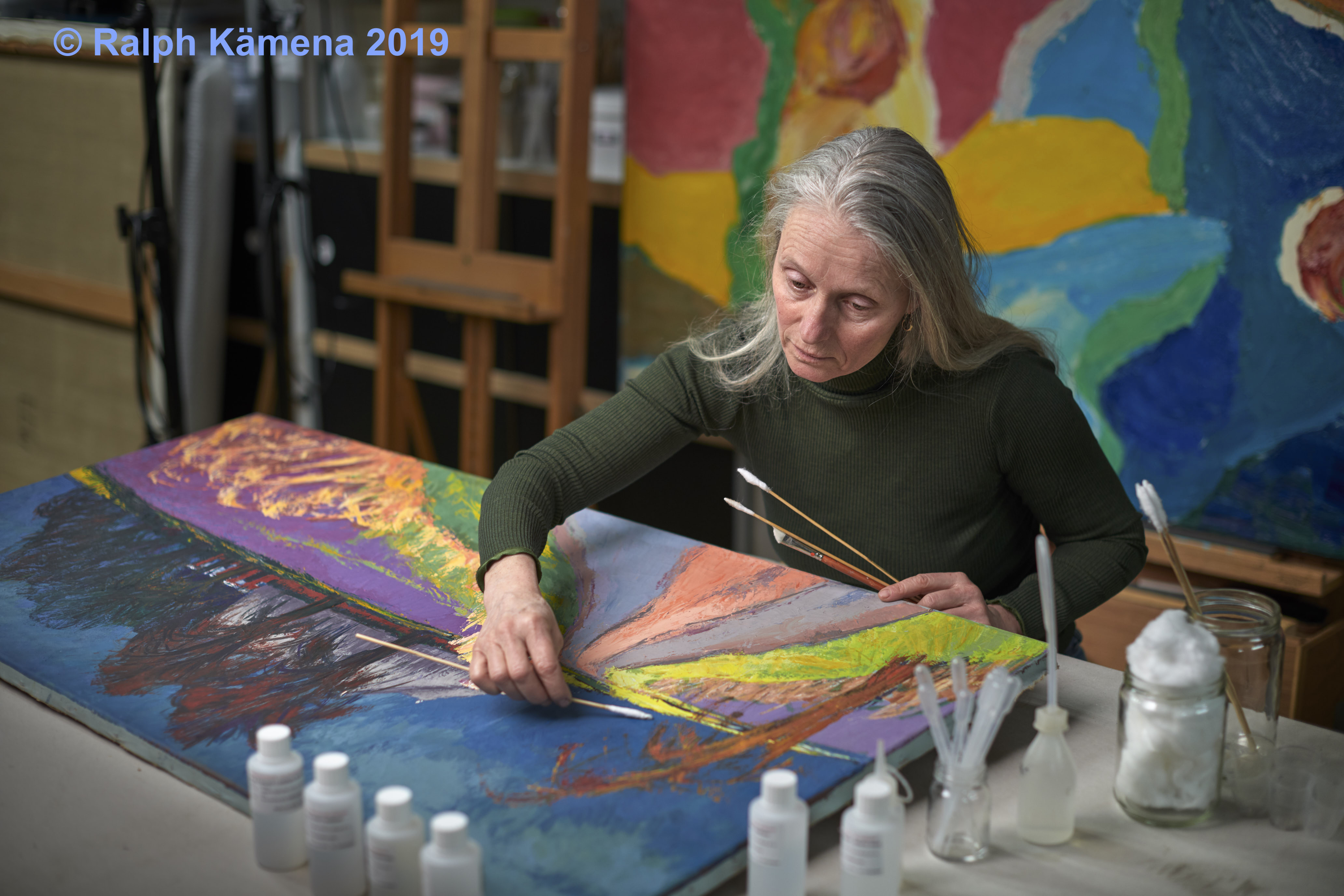Paolo Cremonesi Workshop ‘Materials and methods for surface cleaning and the removal of film-forming materials’.

The Paolo Cremonesi workshop removing film forming materials with the full title: ‘Materials and methods for surface cleaning and the removal of film-forming materials’ Was organised by Nora van der Veer. The Teylers Museum was the location. Classes were on November 13-14 and 15, 2019.
Workshop setup
The daily schedule was the same on all three days. Each day started with theory in the morning and practice in the afternoon. Theoretical lessons were given with a PowerPoint and there was a well-arranged, accompanying folder with PowerPoint images. In the practical, aqueous mixtures were made by Cremonesi. He also made gels. He was sitting in front of us at a table, so we could see him well. Paolo talks and works very calmly and is very clear in the explanation. He also works orderly and above all clean. While mixing he talks about what he does and sees, also talks about restoration and makes jokes. The mixtures were then tested by us on objects brought along.
Paolo Cremonesi had deliberately simplified the program. He had omitted extensive information about the mixtures to be used and detailed chemical formulas. Nora van der Veer did however draw our attention to a Dutch translation of a book written by Cremonesi on this subject. This translation was first published last autumn by De Kunstkliniek Veer & Veer. It describes in detail the chemistry behind the cleaning methods. Very usefull during Paolo Cremonesi workshop on removing film-forming materials.

The theoretical part
Paolo Cremonesi workshop removing film-forming materials
Water, the basis
Cremonesi is very detailed and clear in its explanation of the products. He starts his lecture on the special properties of water. What and why is water so special and why? He compares the high surface tension of water as opposed to the low surface tension of carbon compounds. He also explains the capillary effect that results from this. In this way, we learn how dangerous water can be for our painted surfaces. But also how we can benefit from it in conservation. We are challenged to name the porous materials in the restoration. Cremonesi explains to us that water can penetrate very well and deep into these materials due to the capillary effect. Do we want that? And how can we prevent and/or manipulate this?
Ionize
Water ‘ionizes’ because it can split spontaneously into a + proton (the H +) and – anion (the OH-). When these are in balance, the water is ‘neutral’ and we call this pH 6.7 (pH 7.0). We can also influence its pH ourselves. Adding more H + means that the water becomes acidic. And vice versa, the water becomes basic. From pH 7 to pH 6, the acidity becomes 10x more acidic and to pH 5 100x more acidic. These are major differences, it turns out. However, the surface of a painting can also change the pH of the water. When the pH of the water drops, the surface is acidic. When it goes up, it is basic.
The organic materials that make up our paintings and most other objects oxidize and become acidic. Cremonesi explains why this is so. However, when a painting appears to be basic, we have to be alert. Then the surface may be casein or the painting / object has been cleaned with an alkaline agent in the past. Then stop immediately because the water will reactivate the base (ionize). Ionizing means: attack and remove. Cremonesi has unfortunately seen too many examples from his practice of medieval Italian panels that have been cleaned in the past with sodium hydroxide (NaOH). This cleaning is actually an attack.
Do not use pure demineralised water in the restoration!
So our art objects can influence the pH of PURE water. The result is that the water acquires an unwanted + or – charge. The consequences can include swelling and a white haze. This ionization means that a substance is removed. The film-forming materials of our paintings include: aged oil, old natural resins, beeswax, some synthetic acrylic paints, vinyl groups. Protein-containing materials (animal glues) are even more complex because they are both basic and acidic.
An important lesson from this is that we should never use pure water in the restoration. That is why it is important to measure the pH of the painting first. In this way, we prevent the pH of the water from changing undesirably. Cremonesi teaches us how to measure the pH of the object (see day 2).
Paolo Cremonesi tests a prepared buffer

Which treatment do we choose?
The objective of the treatment is the starting point for making our mixtures. That is why we must be able to determine the material properties of our paintings before a treatment. In this way we are able to work selectively. Will it be cleaning or removing a film-forming layer?
Materials and properties
Materials can be divided into four different groups according to properties:
1) Non polar substances, these are substances with a hydrogen-carbon compound (CH) (Bitumen / microcrystalline wax). This substance will not dissolve in water.
2) Polar substances, these are the substances that, like water, have a + and a – charge (alcohols, arabic gum, starch, methyl cellulose). This substance interacts with the water.
3) The substance enters into a chemical reaction with water, the ionization such as: protein (animal glue or casein).
4) These are the salts, metals, the substances that dissolve in water: pigments that are salts or oxides. Metal soaps are also usually salts.
Cleaning mixtures and parameters
A selection of cleaning products in brief:
Here we learn more from Cremonesi about the materials of the cleaning products to be mixed.
- pH on the adjustment of the acidity. This applies to buffers and metal binders (chelators). The acidity of the mixture is very important for the selection of a suitable metal binder. Because the higher the pH, the stronger the metal binder. For oil paint never go lower than pH 5.5 or higher than pH 8.5.
- Conductivity adjustment. This is also called conductivity. Three possible solutions: hypotonic, (low charge with respect to the object) isotonic (equal charge) or hypertonic (high charge). Pure water is hypotonic and will therefore swell the paint. A mixture that is hypertonic will dry out the paint layer and cause cracking. Isotonic means equal charge and does not cause stress. Modern oil and acrylic paintings and egg tempera paints are sensitive to water, so pay attention to conductivity!
- The application of soaps.
Cremonesi elaborates on how and why of pH choice. He explains the choice of different buffers, metal binders, and loads. He gives many examples and answers all our questions in detail. This is the list of the four properties: Not polar, polar, chemical reaction, or dissolution? For example; “What happens to the film-forming layer if the pH or conductivity of my mixture is not well matched to the paint layer?” Swelling and blanching? Right, ionization!
The practice part
‘Materials and Methods for Surface Cleaning and Removal of Film Forming Materials’.
The paintings brought along are first studied briefly in daylight and UV light. The objective is discussed. Cremonesi has a strong preference for preservation. Preservation of old layers of varnish, but also certain overpainting performed in the past with a different intention than now.
Photo selection objects

We measure the pH of a few objects with an Agarose gel and a pH meter. This is a special Sushi meter (Hanna Instruments). The first test is a drop of pure water on the surface. What does the drop do? Is the surface hydrophobic or hydrophilic? The drop remains round or the drop spreads.
Sushi meter for pH measurement of the Agarose gel

To mix the Agarose, we take 3 grams in 100ml demineralized water. We even choose 5 grams for very water-sensitive surfaces. Cremonesi makes the gel in a microwave. He shows us how to make the right shapes, put them on the paint or varnish surface, and then take the measurement. He also measures the linen on the back in this way

the use of Agarose 
Agarose after treatment
After the measurements, Paolo makes a buffer. First, he mix a 1 molar sodium hydroxide. This is mixed in the correct proportion with a weak acid (acetic acid) with the desired pH 5.5 and conductivity 2.6 millisiemens (the unit for conductivity). Then he makes a buffer of citric acid and sodium hydroxide with pH 5.5. This is also a weak chelator. Finally, he makes another surfactant with Ecosurf EH-9. We carry out the cleaning tests with these three mixtures. We assess whether the result meets our wishes, or whether the mixture needs further adjustment.
An important detail during testing is that Cremonesi deliberately does not turn the cotton swab, but only uses it on one side. After testing, both the painting and the cotton wool are studied in daylight and UV light. Is there a fluorescence from the varnish on the cotton ball? Yes! Because when cleaning a varnish, it is (unfortunately) always affected. This is almost impossible to prevent because it is a porous and oxidized material. These are very important details you learn during the Paolo Cremonesi workshop on removing film-forming materials
For post-cleaning, we use an adapted, water-based on an ammonium carbonate solution, because these substances evaporate easily. The water that is used for this comes from a bottle of mineral water bought at Jumbo. It itself has a pH of 5.5.
Then another Xantan gel is made with one of the three mixtures.
Cremonesi also carefully explains how to calibrate both the pH and the conductivity meter. Here too it works very precisely and cleanly.
Cremonesi says that the top layer of varnish is the most oxidized. Are we going to clean or remove the varnish? He points out that we should not only pay attention to yellowing but also to whitening and the vulnerability of the paint layer and especially the support, especially wooden supports! Cremonesi, therefore, proposes in our case study a gel for cleaning.
Even if the restorer is planning to remove varnish, Cremonesi always recommends cleaning the varnish first. And before removing a varnish, also think about the choice of the new varnish. Why not choose a synthetic polymer under a damar varnish??
Paolo Cremonesi
Cremonesi is a calm and careful teacher, who also provides good practice examples for illustration. He explains the matter clearly, even if he does not go deep into chemistry. He answers questions very clearly and always explains them. This makes it easy to follow his knowledge transfer. His subject matter is larded with humor and ironic comments as well as funny anecdotes. That makes the theory educational and fun!
Epilogue
Since 2007 I have been taking lessons on cleaning New Cleaning Methods with buffers, chelators, and surfactants. I took the first lessons with Richard Wolbers (IAP) in 2007. Then a workshop with Chris Stavroudis about the Modular Cleaning Program (MCP) at the SRAL in 2011. In 2012 I assisted Richard Wolbers in the lab during a workshop organized by Restorers Netherlands in 2012. For a workshop on acrylic paint cleaning, I traveled to Ottawa in 2014, Cleaning Acrylic Paint, CAPS 6, organized by Getty Conservation Institute and Canadian Conservation Institute. Teachers included Alan Phenix and Bronwyn Ormsby. In addition to this, it was very useful for me to also receive lessons from Cremonesi. He literally puts the dot on the i. I recommend colleagues to follow Paolo Cremonesi his workshop on removing film-forming materials
Lunch in the Teylers Museum








